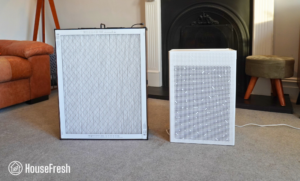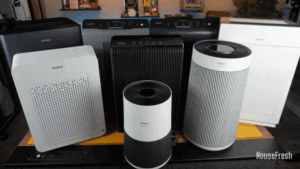Bacteria and viruses are one set of pollutants you really want to keep at bay.
While other pollutants, be it dust mites or cooking odors, are inconvenient, bacteria and viruses can wreak havoc on your health in no time at all.
We have all witnessed the devastating effects viruses and bacteria can have on our society. As recent global events like the COVID-19 pandemic showed us the importance of stopping the spread of infection in our homes and workplaces.
Guidance from health authorities like the CDC and NHS now recommends using HEPA-equipped air purifiers to curb the spread of airborne viruses like COVID-19. Advice that, if shared earlier, could have helped save lives and open up public spaces sooner.
Microscopic bacteria and virus particles can be introduced into a space by an infected person or recirculated as you clean down surfaces and vacuum flooring.
Once inside, they can remain suspended in the air for hours and soon start accumulating in an enclosed space.
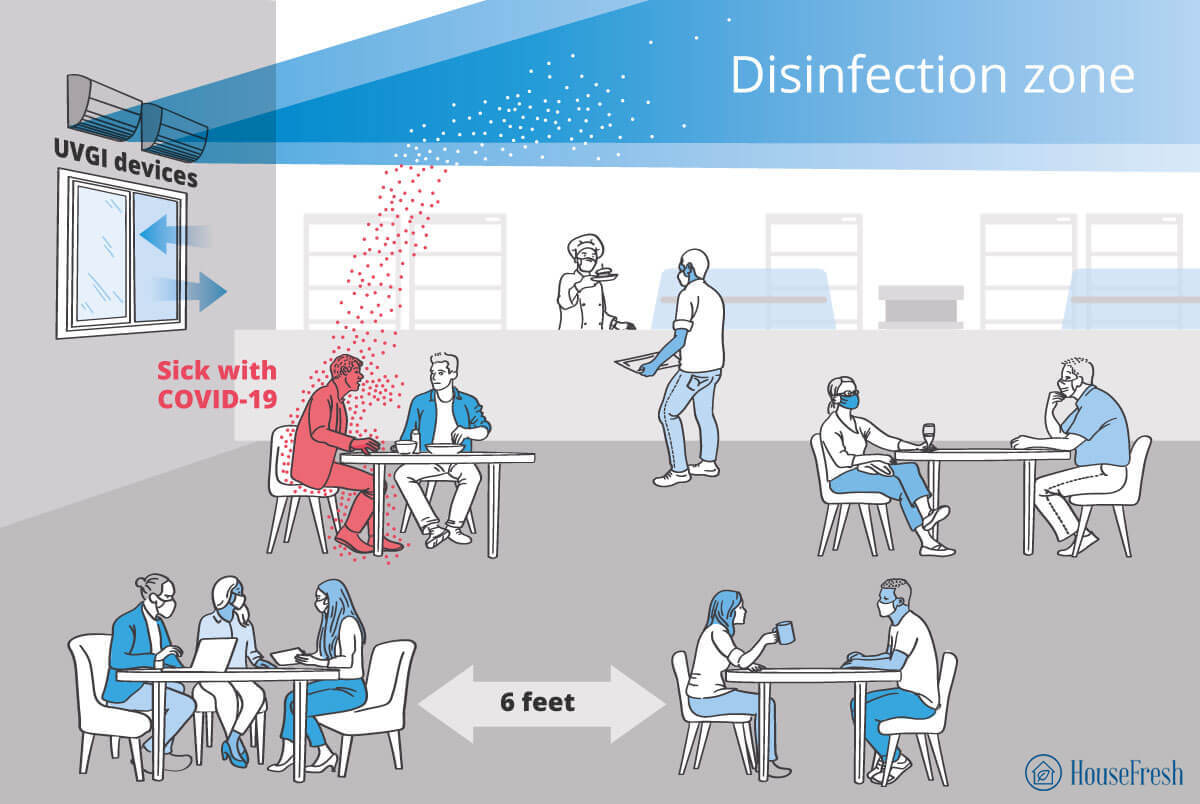
To reduce this build-up of particles, you should aim to change the air inside your space as often as possible. This can be achieved by opening doors and windows and by utilizing a fan or HVAC system. However, the average home only manages to complete 0.5 air changes per hour.
Air purifiers, on the other hand, can achieve much better air circulation. With the right unit, you should be able to see as many as 5 air changes per hour. Plus, if equipped with medical grade H13 filters, it can remove the smallest bacteria and virus particles, leaving clean and healthy air to be redistributed throughout your space.
Bacteria and virus particles will exist in every home. Whether the cold and flu virus, mold, E. coli, salmonella, or even super viruses such as MRSA. If left unchecked, exposure to these particles can have severe health implications.
As these particles are so small, they can remain airborne for hours. This is where an air purifier can help keep your home free from viruses and bacteria. When compiling this list, I’ve paid close attention to units utilizing HEPA filters (ideally H13 certified) to guarantee the removal of the smallest virus particles.
Having analyzed our testing data, I have selected the best air purifiers for bacteria and viruses available on the market right now.
Staff pick: IQAir HealthPro Plus
With industry-leading filter technology, the HeathPro Plus is trusted in hospitals around the world.
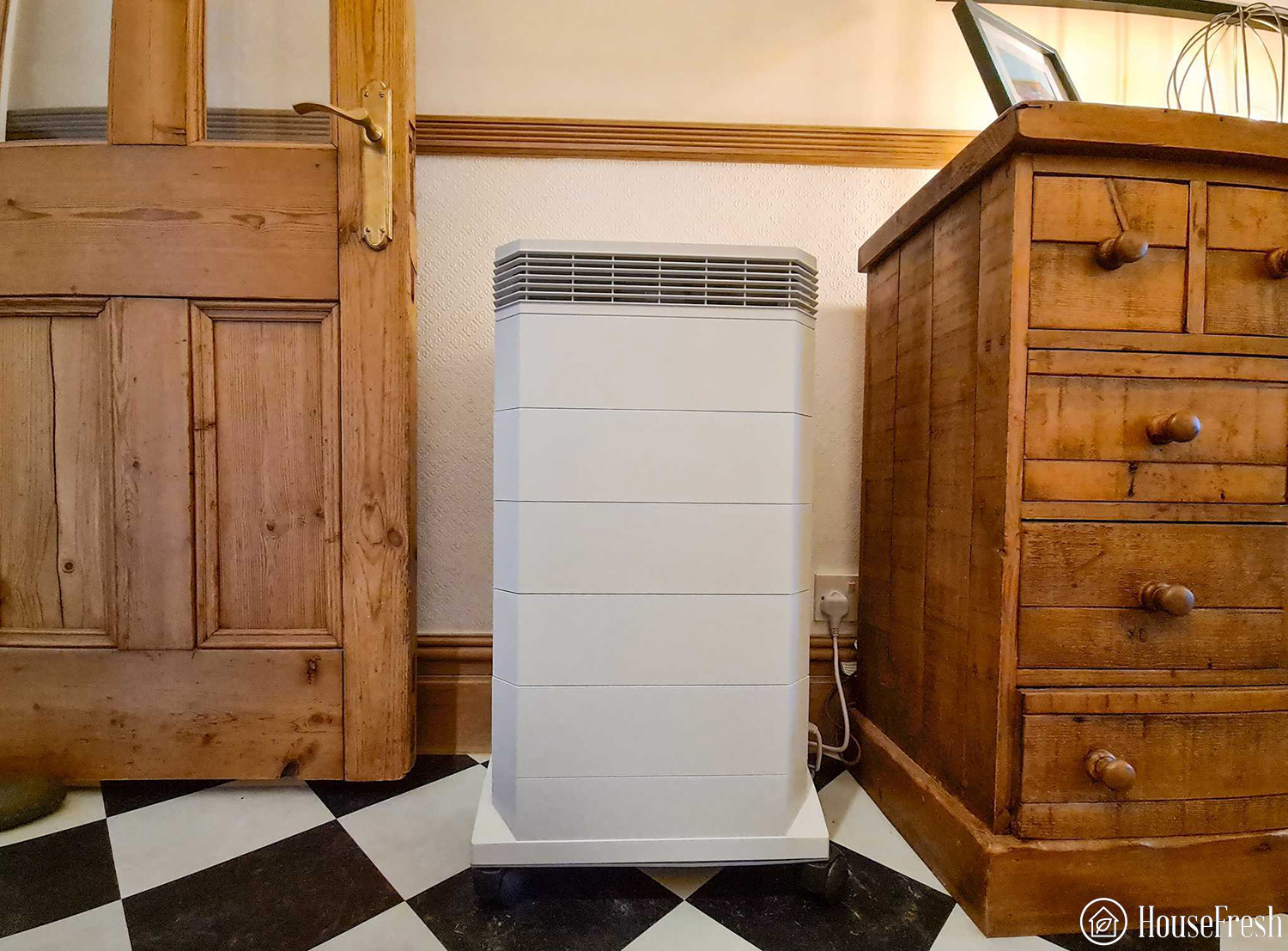
IQAir has been in the air purification business since 1963, making it a leader in the industry. It is a family-owned business headquartered in Switzerland with offices in Germany, the U.S. and China. All their air purifiers are developed in Switzerland, with manufacturing facilities located in Switzerland and Germany.
The IQAir HealthPro Plus is a powerful air purifier perfect for large rooms up to 1,125 square feet, winning several awards for its performance in cleaning indoor air, including the top air purifier award from the Evening Standard in the UK.
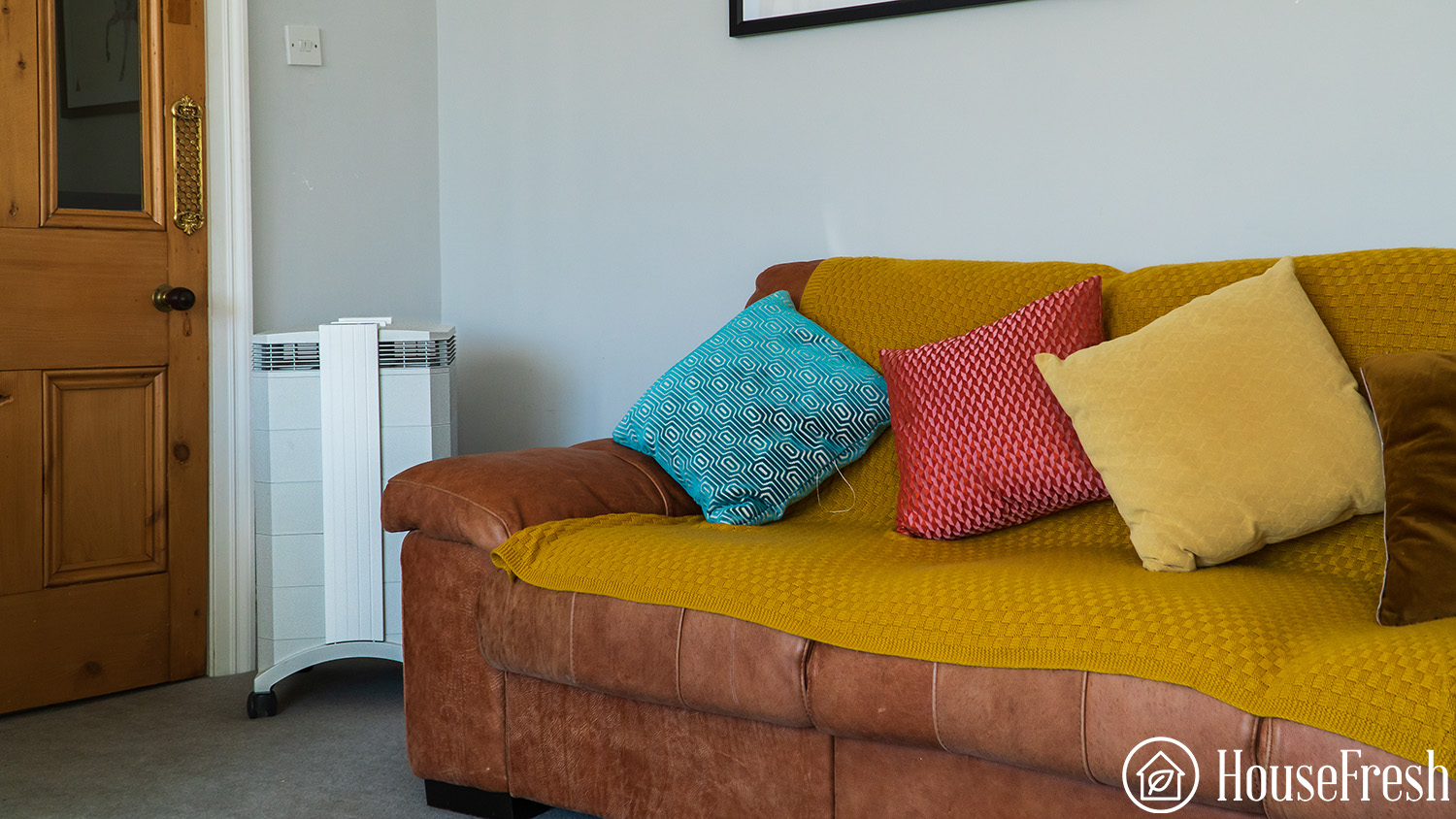
What we really like
What we think could be better
Part of the reason why the IQAir HealthPro Plus is so well regarded is due to the powerful filtration under the hood. The HealthPro Plus employs what the company calls HyperHEPA filtration technology, which is independently verified to capture ultra-fine particles that are ten times smaller than a virus.
When we tested this air purifier in our home lab, we weren’t surprised to see how fast it could clear the air from incense smoke pollutants and the associated smells. You can see the speed at which the HealthPro Plus works in the video below:
The filter of the HealthPro Plus also contains a powerful V5 Cell activated carbon filter that removes odor, VOCs and other gaseous pollutants from the air in your home.


Unfortunately, all this high-performing technology comes at a cost. With each unit made and tested meticulously in IQAirs’ Swiss factory, the HealthPro Plus is the most expensive unit on our list. Having tried this unit in my home for a while, I can testify that it is worth the price.
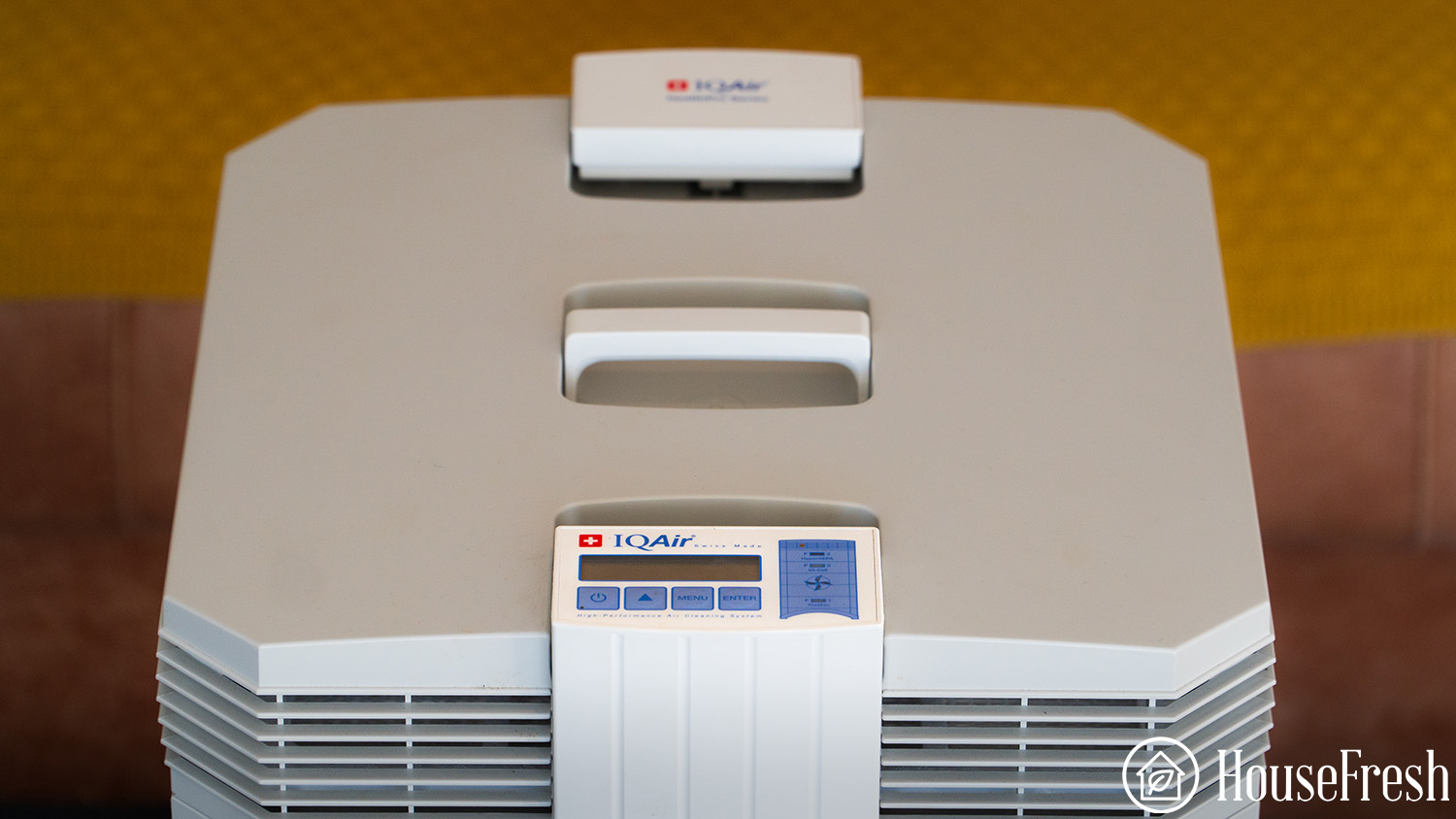

| HouseFresh rating: | ★★★★★ |
| Time to clean our 728 cubic feet test room (with the device running at top speed): | 28 minutes |
| Air purifier technology: | HyperHEPA and V50-CELL gas and odor filter |
| Recommended room size (5 air changes per hour): | 375 sq. ft. |
| Clean air delivery rate (CADR): | Estimated: 250 CFM |
| Dimensions (in inches / in cm): | 28H x 18W x 16D inches (71H x 38W x 41D cm) |
| Weight (in pounds / in kg): | 35 lbs (15.88 kg) |
| Filter life: | 4 years |
| Noise level (measured from 3 ft. away): | Speed 1: 36.9 dB Speed 2: 37.2 dB Speed 3: 40.9 dB Speed 4: 47.2 dB Speed 5: 53.9 dB Speed 6: 61.2 dB |
| Electricity consumption in watts (recorded with an electricity usage monitor): | Standby mode: 1 watts Speed 1: 16.5 watts Speed 2: 32.7 watts Speed 3: 47.3 watts Speed 4: 69 watts Speed 5: 94.3 watts Speed 6: 145.2 watts |
| Estimated running costs (electricity consumption + filter replacements): | $421.47 per year |
| Cost per CADR cfm (based on dust CFM as reported by AHAM): | $3.60 |
| Manufacturer’s warranty: | 10 years |
| Country of manufacture: | Switzerland / Germany |
Best for less than $200: Winix 5500-2
The Winix 5500-2 provides comprehensive cover from bacteria and viruses without costing a fortune.

Winix has been making air purifiers since the 70s, so it’s fair to say they know a thing or two about keeping indoor spaces free from pollutants like bacteria and viruses. Each of their units is designed and made in South Korea to meet the needs of the modern user in a complex, modern world.
Despite its wallet-friendly price tag, the Winix 5500-2 ticks all the right boxes. It provides powerful air circulation in rooms up to 360 sqt ft. and high-quality filters to remove tiny particles, which we saw firsthand during our air cleaning speed test, where it cleared all traces of simulated pollutants in just 19 minutes. Another key stat to take away is the excellent CADR score of 240 CFM. This figure is AHAM verified and really drives home the great value on offer.
What we really like
What we think could be better
The 5500-2 uses a True HEPA filter that, according to Winix, is capable of capturing 99.99% of the particles as small as 0.003 microns. This means even the most minuscule virus particles will be removed from the air. The 5500-2 also comes with a pre-filter and activated carbon filter. both of which are removable and washable to keep them performing at their best for longer.
This unit also uses Plasmawave, which is just a fancy name for an ionizer. For those who have respiratory conditions, the good news is that this function can be switched off completely. And even without it, you won’t see a drop off in air cleaning functionality either — we ran two tests with this unit, and without its ionizer, it completed our speed test just three minutes slower.


| HouseFresh rating: | ★★★★★ |
| Time to clean our 728 cubic feet test room (with the device running at top speed): | 23 minutes (with PlasmaWave) |
| Air purifier technology: | PlasmaWave, removable pre-filter, washable activated carbon filter and True HEPA filter |
| Recommended room size (4.8 air changes per hour): | 360 sq. ft. |
| Clean air delivery rate (CADR): | Dust: 243 CFM Smoke: 232 CFM Pollen: 246 CFM |
| Dimensions (in inches / cm): | 15W x 8.2D x 23.6H inches (38W x 21D x 60H cm) |
| Weight (in pounds / in kg): | 14.8 lbs (6.7kg) |
| Filter life: | 12 months |
| Noise level in decibels (measured from 3 ft. away with a sound level meter): | Speed 1: 38.8 dB Speed 2: 42.5 dB Speed 3: 47.5 dB Speed 4: 58.9 dB |
| Electricity consumption in watts (recorded with an electricity usage monitor): | Standby mode: 0.34 watts Speed 1: 6.5 watts Speed 2: 9.11 watts Speed 3: 14.80 watts Speed 4: 53.46 watts |
| Estimated running cost (electricity consumption + official filter replacement): | $161.53 per year |
| Cost per CADR cfm (based on dust CFM as reported by AHAM): | $0.66 |
| Manufacturer’s warranty: | 2 year |
| Country of manufacture: | South Korea |
Best for large spaces: Smart Air Blast Mini
The Blast Mini is a behemoth air purifier that will surprise you with its super quiet operating volume.
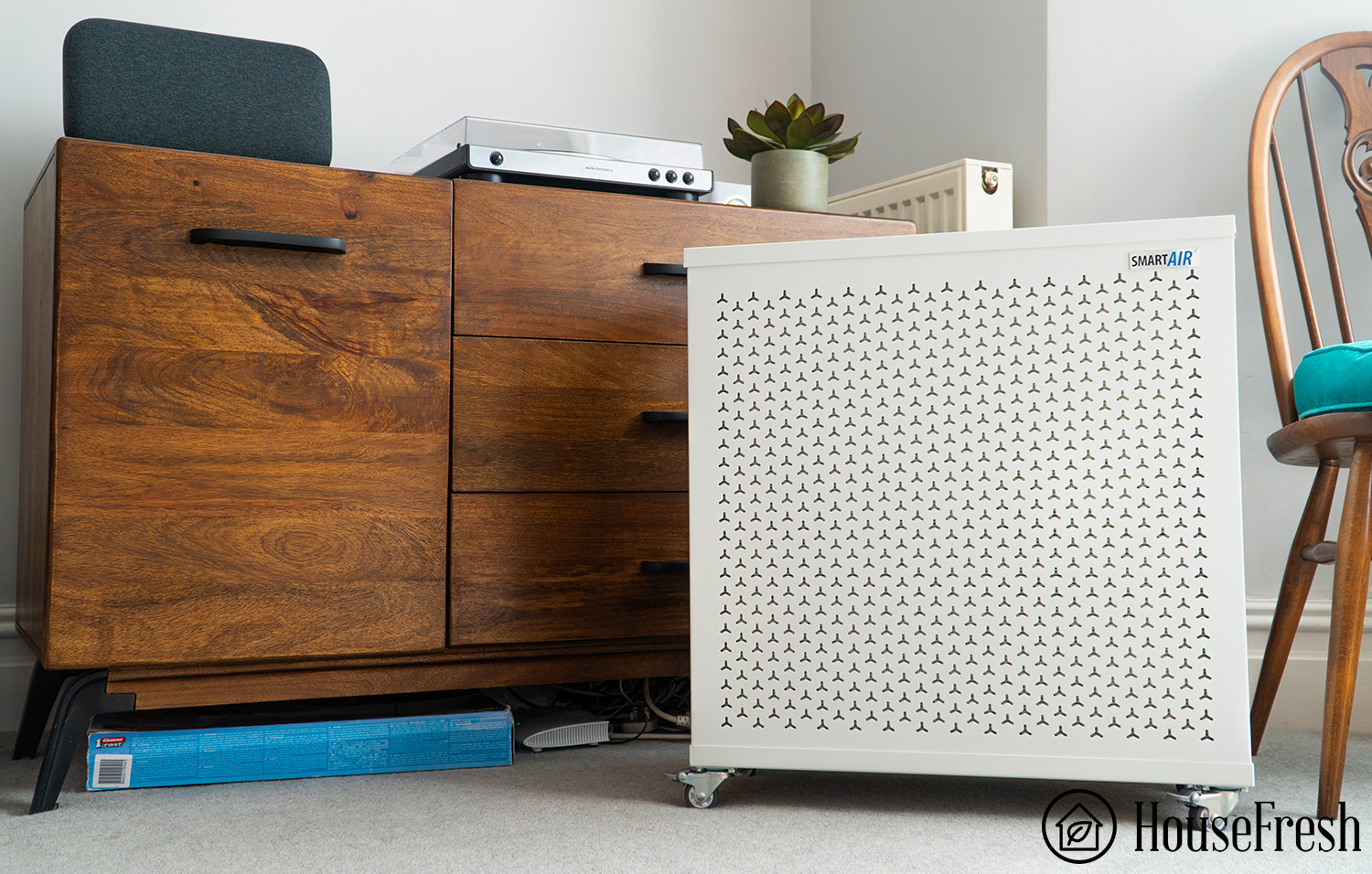
Smart Air is relatively new to the market, but their Blast Mini air purifier is a force to be reckoned with despite its “Mini” title. The Smart Air Blast Mini is a high-capacity, quiet HEPA air purifier effective for schools, hospitals and homes. This unit can deliver 820 cubic feet per minute (CFM) of air, making it excellent for use in large spaces of up to 915 sq. ft.
What we really like
What we think could be better
The Blast Mini comes equipped with a True H13 HEPA filter, capable of capturing both 0.3-micron and 0.07-micron particles. These filters can effectively eliminate dangerous airborne viruses, bacteria and other pollutants from the indoor air. A heavyweight activated carbon filter also traps gaseous pollutants such as radon, smoke and volatile organic compounds (VOCs).
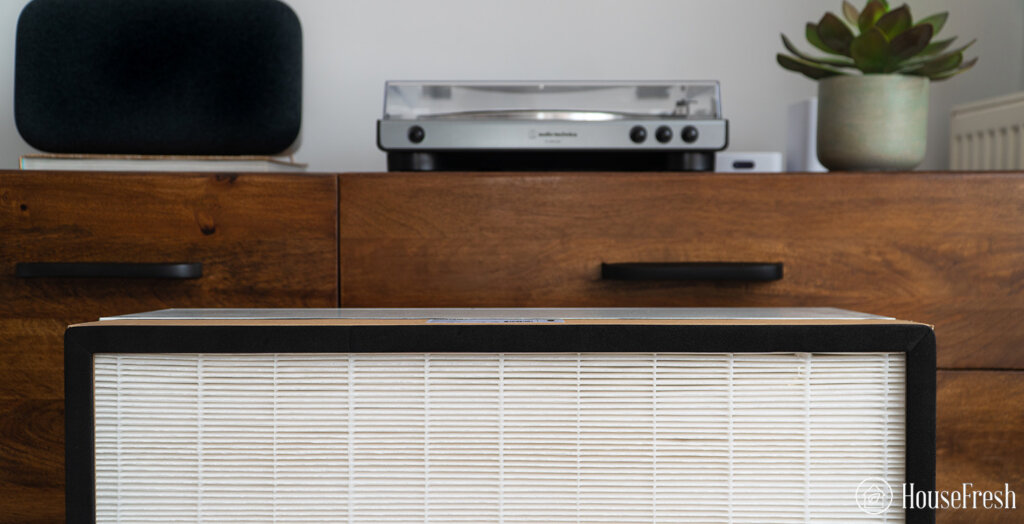

The Blast Mini is easy to operate as it lacks intelligent controls. It only features one dial that allows you to select between its three-speed settings. While you won’t find a smart sensor or digital display, you’ll appreciate its power and ability to deliver clean air in extra-large rooms.
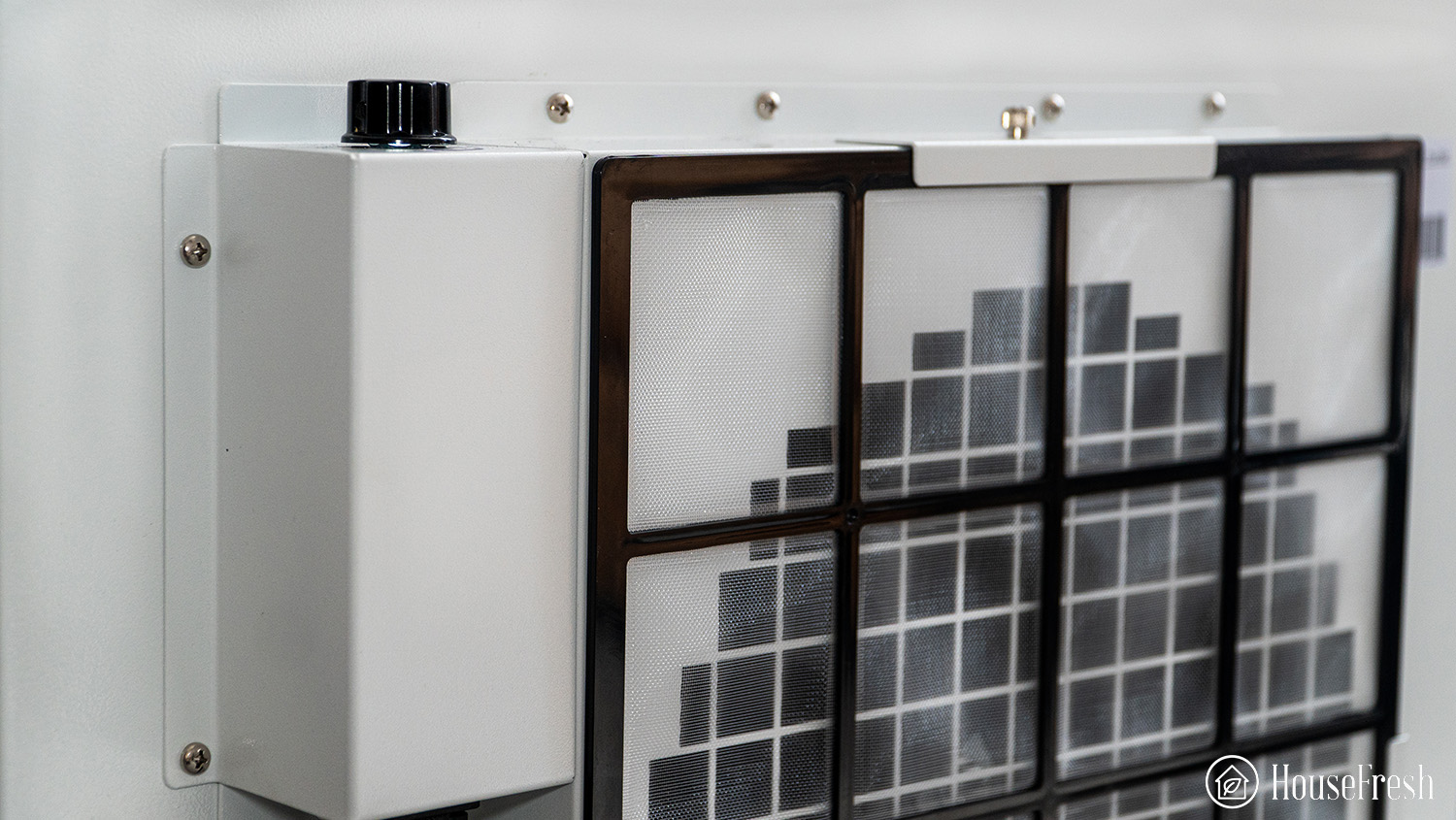
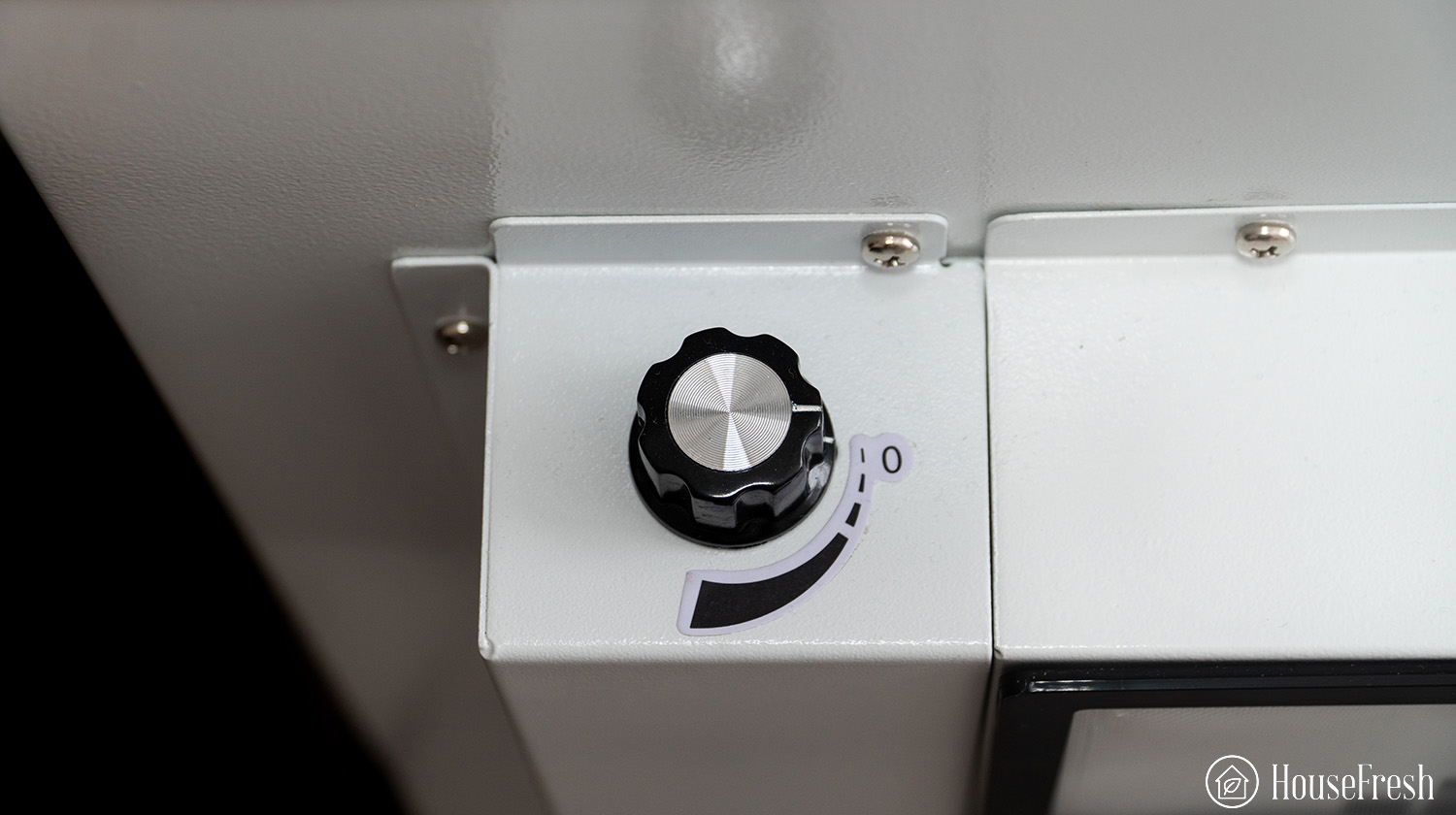
| HouseFresh rating: | ★★★★★ |
| Time to clean our 728 cubic feet test room (with the device running at top speed): | 15 minutes |
| Air purifier technology: | H13 HEPA filter (and optional activated carbon filter) |
| Recommended room size (4.8 air changes per hour): | 703 sq. ft. |
| Clean air delivery rate (estimated CADR): | 435 CFM |
| Dimensions (in inches / in cm): | 22.6L x 13W x 24.8H inches (57.5L × 33W × 63H cm) |
| Weight (in pounds / in kg): | 59 lbs (26.8 kg) |
| Filter life: | 13 months |
| Noise level in decibels (measured from 3 ft. away with a sound level meter): | Speed 1: 44.9 dB Speed 2: 51.2 dB Speed 3: 56.3 dB |
| Electricity consumption in watts (recorded with an electricity usage monitor): | Standby mode: 0 watts Speed 1: 51.9 watts Speed 2: 87.4 watts Speed 3: 122.7 watts |
| Estimated running cost (electricity consumption + official filter replacement): | $285.29 per year |
| Cost per CADR cfm (based on dust CFM as reported by AHAM): | $1.38 |
| Manufacturer’s warranty: | 1 year |
| Country of manufacture: | China |
Other air purifiers that can help with bacteria and viruses
- Honeywell HPA300 – With a CADR of 300 CFM (509 m³/h), the HPA300 is a powerful air purifier for rooms as large as 465 sq. ft. that will cost you less than $250. It uses True HEPA filters, so you can rest assured that virus and bacteria particles as small as 0.3 microns will be removed. This unit didn’t make our staff picks because it is a little dated (no smart functions) and, despite being Energy Star certified, it is power-hungry in comparison to more modern air purifiers.
- Alen BreatheSmart 75i – The Alen 75i is an excellent air purifier for large rooms up to 1,300 sq. ft. It boasts a CADR of 347 CFM and comes equipped with a True HEPA filter and large amounts of activated carbon, meaning it can remove 99.99% of airborne contaminants down to 0.1 microns as well as odors and VOCs. The 75i didn’t make the staff picks because it is bulky and it comes at a high price tag, considering its performance.
- Mila Air Purifier – Packed full of high-tech air sensors, the Mila is the smartest purifier on the market, with a CADR of 263 CFM (447 m³/hr) and a selection of seven customizable HEPA filters to tackle the main indoor pollution issues the average household is likely to experience. It looks like a beautiful piece of furniture but it didn’t make it to our staff picks list because it is really expensive due to the eight sensors that make the smart magic happen.
- Levoit Vital 200S – With a CADR of 245 CFM, the Levoit Vital 200S is capable of delivering 5 air changes an hour in a room as large as 375 sq. ft. This makes it one of the best-performing air purifiers on the market for less than $200. Levoit currently advertises that the Vital 200S comes with a medical grade H13 HEPA filter, but this unit didn’t make the staff picks because we can’t 100% trust that claim after Levoit had to stop advertising the use of True HEPA H13 filters in other units after being challenged by Dyson through the BBB National Programs National Advertising Division (NAD).
The units we tested but don’t recommend for bacteria and viruses
- Austin Air HealthMate – With one of the biggest carbon filters out there, the Austin Air certainly has its merits. When it comes to bacteria and viruses, however, I found it lacks the air cleaning speed to capture particles before they pose a threat.
- Levoit EverestAir – Despite being the fastest air purifier we’ve ever tested, we wanted to focus our top picks for bacteria and viruses on units that use medical grade HEPA filters, which are guaranteed to remove the smallest particles.
- Levoit Core 300S – For everyday use, the 300S is a great, cost-effective unit. Yet as a small unit with less powerful fan speeds, it’ll struggle to make a dent if pitted against a room with a high viral load.
- Blueair Blue Pure 211+ – Blueair makes a range of excellent air purifiers, with the 211+ being the pick of the bunch. But their stellar performance is seriously let down by the fact you can’t switch off the unit’s ionizer function. This feature is far from ideal for any users with immunodeficiency disorders or respiratory issues.
What to look for when buying an air purifier for bacteria and viruses
1. Does the air purifier use high-quality filters?
Air entering the air purifier will pass through a series of filters responsible for removing pollutants such as bacteria and viruses.
To remove these particles effectively, the air purifier must use high-quality filters. A great rule of thumb is to look for the HEPA certification. This guarantees the filter will be able to remove 99.97% of particles as small as 0.3 microns – the average particle size of a virus.

Many other types of filters exist, including HEPA-type, UV-C, Ionizoer and PECO. After reviewing each of these types of filters, I advise you to steer well clear of any unit that relies on these technologies.
HEPA-type and PECO are simply not good enough to remove the smallest particles. While Ionizers and UV-C technology, which is often described as a bacteria neutralizer, can be even more problematic as they have both been found to emit ozone into the atmosphere. Which in turn can trigger respiratory conditions and exacerbate illness and disease.
2. Is the air purifier powerful enough for your space?
As the CDC recommends a minimum of 5 air changes per hour to reduce the risk of viruses such as COVID-19, you’ll need to ensure the air purifier you choose is powerful enough to achieve such results.
Manufacturers often share a recommended room size for each of their units to allow consumers to gauge if the purifier can adequately circulate the air in their space.
This is a good starting point to help you narrow down options, but I recommend looking into each option’s CADR score for a better (and independently verified) picture of how powerful an air purifier is.
Use our easy-to-use calculator below to find the minimum CADR requirements an air purifier will need to circulate air effectively in your specific space.
3. Is the air purifier easy to live with?
Bacteria and viruses exist in our homes around the clock, so in order to remove particles and limit your exposure, you’ll likely need to use your air purifier 24/7 too.
This means you need to consider how much the purifier will cost to run and whether or not it will create sound volumes that will disturb your day-to-day life.
During our hands-on air purifier reviews, we measure the watts consumed on each speed setting as well as the volumes an air purifier creates. Be sure to check out our findings on your chosen air purifier’s in-depth review or take a peek at the Specs and Features table found below each unit in this article.
Common questions about air purifiers, bacteria and viruses
Studies have found that approximately 60% of respiratory and gastrointestinal infections affecting humans are contracted indoors.
The most common viruses found indoors are:
- The common cold is characterized by sneezing, a runny or congested nose, sore throat, coughing, watery eyes and sometimes fever.
- The flu is marked by fever, cough, sore throat, nasal congestion, muscle or body aches, headaches and fatigue.
- Bronchitis presents with chest congestion, wheezing, coughing, headaches, body aches, fever and fatigue.
- Gastrointestinal infections lead to symptoms like gastroenteritis, diarrhea and vomiting.
Common bacteria found in homes include:
- Staphylococcus can induce skin infections ranging from minor boils to severe antibiotic-resistant or flesh-eating conditions, depending on the strength and depth of the infection.
- Bacillus is associated with two forms of food poisoning — a rapid-onset variation with nausea and vomiting and a slower-onset version with diarrhea.
- Micrococcus can provoke skin infections with intense itching, occasionally escalating to severe conditions like septic shock and pneumonia.
- Mycobacterium tuberculosis triggers TB disease, and the symptoms depend on where TB bacteria are growing in the body. Typically, TB bacteria grow in the lungs and can cause bad cough, pain in the chest, coughing up blood or phlegm, fatigue, fever and lack of appetite.
Germs spread through direct and indirect contact. Through direct contact, germs can spread person-to-person through a handshake, hugs, or kissing. As for indirect contact, they move around via people touching a surface with germs and then touching their face (e.g., eyes, nose, mouth). They can spread through saliva as well from sharing drinks.
Germs can also be airborne. When someone coughs or sneezes, the droplets fly into the air, containing contagious bacteria and virus particles. They can travel up to 6ft away, remaining airborne for hours at a time, before landing on either a surface or another person.
Understanding the difference between bacteria and viruses requires some biological insight. With bacteria, they are free-living cells. They can survive as quickly outside a body as they can inside it. On the other hand, viruses are a collection of non-living molecules. So, they need a host to live.
Viruses are some of the smallest airborne particles found inside the home, measuring as small as 0.1 micron. So in order to remove them, you’ll need an air purifier with dense enough filters.
Filters are made up of tightly woven fiberglass strands. How well they perform correlates to how dense these strands are packed, which creates a tighter net to catch particles.
Look out for a HEPA certification to identify a quality filter that will work against the smallest virus particles. This sliding scale determines how effective a filter is, ranging from H10 HEPA, which is guaranteed to remove 85% of particles as small as 0.3 microns, to H14 HEPA, which can remove 99.995% of particles:

In the wake of the COVID-19 pandemic, studies have looked into how effective HEPA filters are at removing coronavirus particles, which can measure as small as 0.1 micron. Results showed that HEPA filters were highly effective at removing the microscopic virus, with increased air changes leading to a 99.97% removal rate.
Portable air purifiers have seen an increase in popularity following the COVID-19 pandemic. Designed to be worn on a necklace by the user, they claim to offer protection from viruses in the wearer’s immediate airspace.
Although this sounds like a great idea in practice, in reality, the technology isn’t there just yet.
As these are super small devices, they lack the powerful fans and filters required to circulate air and remove pollutants before being inhaled by the user. Instead, manufacturers are opting for ionizer technology to achieve better results.
Besides running the risks of exposure to ozone with this filtration method, it can also act as a magnet for harmful pollutants. As the ions attach to the virus particles, they then land on your clothing, skin or face without being drawn into the personal purifier device – actually increasing the risk of being exposed to a viral pathogen.
An independent study looked into personal purifier effectiveness, with pretty dismal results. Having tested four different options, each utilizing an ionizer to enhance performance, three units only managed to clear 10% of particles from the controlled space. With even worse performance expected in the real world.
Similar to viruses, air purifiers can work wonders against bacteria if they possess powerful fans and quality filters.
Bacteria particles range between 1 and 10 microns, meaning they fall within the size range that HEPA filters can remove.
Remember that an air purifier can only remove bacteria particles that are airborne. Bacteria that exist on surfaces like handrails, cell phones and tables will continue to pose a threat. Use your air purifier in conjunction with regular sanitizing of surfaces for comprehensive protection.
Wrapping up
Bacteria and viruses are sadly a part of life, and each time you go outside, there’s a chance you or your family can bring them back home. So, one of the best ways to combat this situation is by installing a high-quality air purifier in your rooms.
Air purifiers can reduce contaminants like germs, as they contain HEPA filters of different gradients. Household air purifiers’ most effective HEPA filters are H13 or medical grade. These will clear 99.99% of pollutants like bacteria and viruses from the air in your home.
You must choose the right air purifier for the size of your room. Choosing one too large or too small won’t work as efficiently as it should. So make sure to measure your space before shopping.



